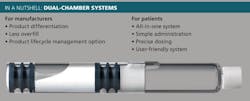Freeze-dried products are currently omnipresent and gaining more and more ground in the pharmaceutical market. If international pharmaceutical and biotech industries want to keep up, they are compelled to reconsider their strategies. In the past few years, no fewer than 30% of all FDA approvals for parenteral drugs were given for lyophilized products. Market research is even predicting that 50% of all parenteral drugs will be lyophilized in the future. For the manufacturers involved, the major change lies in the challenges affecting the choice of packaging.
Lyophilization is particularly advantageous for complex and highly sensitive substances. For instance, freeze-drying increases a drug’s resistance to heat, light, and other external influences. Development, manufacturing and delivery of such substances, however, demands different requirements than with liquid formulations. Galenic formulation for example, requires other excipients, while manufacturing demands efficient freeze-drying cycles. Also, the drug has to be reconstituted completely and safely immediately prior to administration.
A STRATEGY FOR THE LONG TERM
Lyophilized drugs require manufacturers to think carefully about what kind of packaging their product will need; usually vials or dual-chamber systems, with the latter being either syringes or cartridges. These two systems involve different manufacturing processes and, later delivery steps. Each offers specific opportunities that depend on the competitive situation. When determining the most adapted packaging for the chosen system, companies should take into consideration three critical factors:
• The market – What other drugs are available, and in what drug delivery system?
• The user – Who will be performing the injection, and will the user group be expanded to the homecare segment at a later date?
• Packaging know-how – Does the company itself or a contract development and manufacturing organization (CDMO) dispose of efficient production technologies and innovative injection systems?
INNOVATORS FAVOR VIALS
Vials are a good option if the product is a genuine innovation with no visible competition in the medium-term. They are less complex than other options, and the manufacturing processes are fairly standard. Choosing vials reduces time-to-market which, in turn, optimizes the duration of patent protection.
At the same time, vials require experience for the reconstitution of the drug and for producing an accurate dosage. If the user group includes not only doctors and nursing staff, but also patients and/or their relatives, then companies have the option of using auxiliary devices. For example, vials can be equipped with adapters that make reconstitution far easier to manage. Some CDMOs also have prefilled syringes with sterile water for injections (sWFI) in their portfolio.
For users with little practice, these combinations provide an adequate and reliable solution. The systems are built to produce the precise dose of reconstituted substances, therefore, adapters and sWFI syringes are an option to support all user groups. When competitors appear on the market at a later stage, a company’s product can then be differentiated by greater user-friendliness. Of course, this only applies if the competitor’s drug has also been lyophilized and packaged in a vial.
USER-FRIENDLINESS – A REAL USP
Innovative syringes and cartridges also represent product differentiation vis-à-vis vials. For the professionals, they simplify the process and save time. Regarding the number of applications, doctors and caregivers save valuable time in the treatment and care of patients. In addition, the all-in-one-system reduces the risk of needle stick injuries which can represent a problem with vials.
The dual-chamber systems also open the way to entirely new segments such as the homecare market. Thanks to the injection systems, patients and their relatives can perform the injections themselves if need be, without fear of erroneous dosage. This is a genuine relief, particularly for patients who have to take medication themselves over longer periods. Of course, this particular segment includes unpracticed users with chronic illnesses. Such users often have the necessary experience, but their illness means they are less able to inject themselves due to declining muscular skills. All-in-one systems will then mean safer self-medication.
The dual-chamber systems can also be made even more user-friendly if extended with auxiliary devices. For example, for multi-doses there is the dual-chamber cartridge in a pen system. These devices are especially suited for medication destined for children and older people while having the additional advantage of reducing the users’ possible fear of the needle.
THE FUTURE IN LIFECYCLE MANAGEMENT
For drug manufacturers, the dual-chamber system offers a competitive alternative for sensitive substances. They do, however, have another advantage as they allow a company to design a coherent life-cycle management strategy based on the competitive situation. For instance, innovators can put a lyophilized drug on the market in a vial at the start of a lifecycle and profit well from it. If the competition introduces the same product, the company can then focus on the user perspective. Additional value can be obtained by the use of adapters and sWFI syringes. If the market situation requires standalone features for the drug, then switching to a dual-chamber system will be an option. With pens, this solution can be further improved to enable continuing gain of market share.
KNOW YOUR PACKAGING
When choosing the packaging, comprehensive knowledge of the systems and its processes is a key factor. While the dual-chamber systems offer many competitive advantages, they also demand a high level of skill and knowledge in developing and manufacturing. For instance, the dual-chamber system has both an end and middle stopper. Construction and assembly of the syringes and cartridges must be adapted to allow for appropriate break loose and glide forces in order to make the injection process smoother.
Special technologies and processes are also necessary to enable efficient manufacturing of freeze-dried drugs. To avoid losses of the active substance, the preferred option is in-situ lyophilization. But that option demands special knowledge of both formulation and process know-how. For example, because the substance is filled into the front chamber, the distance between the API and the freeze dryer shelf is greater as compared to a vial. This difference in heat transfer and the narrower glass barrel dimension result typically in lower sublimation rates, and the composition and concentration of the excipients must be also sometimes adapted accordingly. The lyophilization cycle will be different and might be only slightly longer. However, the loss of active substance is minimized since the dual-chamber system requires up to 20% less overfill depending on the filling volumes.
ABOUT THE AUTHOR
Thomas Otto has been a Managing Director of Vetter Pharma-Fertigung GmbH & Co. KG since December 2002. He joined the company as a project engineer in 1990 after graduating from the Technical College in Stuttgart with an engineering degree in packaging technology and print processing. From 1995 to 1999, Otto managed the department of packaging materials development. From 2000 to 2002, he directed the department of research & development as Vice President.





